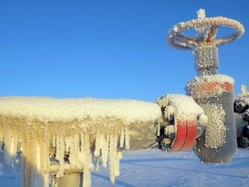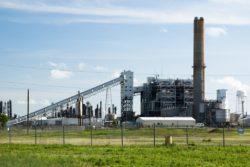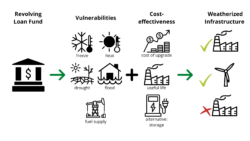

By Margaret Cook, PhD, Research Associate; Gavin Dillingham, PhD, Program Director; and Deborah Nabaloga, Research Assistant
The biennial Texas Legislative session has wrapped up. Of significant interest for many of us Texans was how the legislature was going to take steps to prevent a future Great Texas Blackout, like the one experienced in February. A variety of proposals were brought forth to mitigate this future risk, including energy efficiency to reduce load, interconnecting to the national grid, improved demand response, etc. None of these ideas got much traction.[1] What the state ended up with was Senate Bill 3 (SB 3). SB 3 took at step in the right direction. However, there are two key pieces that are missing, resiliency funding to do the winterization and energy efficiency. Both of these items were considered in the earlier bill but were removed in the final draft. Our focus for this post is the missed opportunity for resiliency funding. We will address energy efficiency in a later post.
Overview of SB 3
A key component of this bill is that the regulators must consider weather predictions from the State Climatologist when putting together weatherization rules. This step is significant as the current method for energy system planning and operations uses historical weather data, assuming that the weather today will look like the weather of the past. Texans should know by now that this assumption does not hold water (or power). The bill also sets up an emergency alert system to let people know when the grid is under duress. There is also some language that improves coordination and communication between the natural gas suppliers and power producers. Finally, there was the much-needed step to require that critical gas facilities be identified, mapped, and registered with power utilities so they will not get turned off during a major outage event.
[1] Additional bills addressed energy-related concerns but did not aim to prevent another Great Texas Blackout from occurring again, including HB 4492: a bill to loan $800M to ERCOT for debts and for $2.1B in bonds for electric companies; SB 1281: a bill to reduce grid congestion and cost of transmission projects; SB 398: the solar bill of rights; SB 2154: reforming PUC membership, SB 713: moving PUC/ERCOT to earlier sunset review; SB 2: ERCOT reform; and SB 2116: relating to foreign-owned critical infrastructure.

SB 3 also addresses some of the critical issues by requiring the development of rules for weatherizing power plants and some natural gas suppliers that provide gas to power plants. The Texas Electricity Supply Chain Security and Mapping Committee is established in SB 3 to map critical infrastructure within the electricity supply chain in Texas. The bill requires the Railroad Commission of Texas to create rules requiring gas supply chain infrastructure (used for producing, treating, processing, pressurizing, storing, or transporting natural gas) identified in this process to weatherize. Penalties for failing to do so range from $5,000 to $1 million per day that they are not in compliance after inspection. The bill similarly requires the Public Utility
Commission to create rules requiring power generators to “provide adequate electric generation service during a weather emergency” based on its adopted reliability rules. There is no explicitly outlined fine for power generators that fail to weatherize in SB 3, but the bill allows the PUC to impose one. After the 2011 outage, the Federal Energy Regulatory Commission (FERC) and North American Electric Reliability Corporation (NERC) determined that winterizing equipment for Texas gas plants could cost $50,000–$500,000 per plant. Researchers from the Federal Reserve Bank of Dallas calculated that installing the recommended equipment on all gas-powered plants in Texas could cost up to $95 million today (adjusting for inflation and assuming the FERC/NERC assumptions are valid). They estimate an additional $85 million–$200 million annually would be needed for gas wells.

What Could Have Been: Resiliency Funding
According to ERCOT, natural gas plants shutting down or reducing power production due to the freeze was the most significant source of outages. SB 3 requires the weatherization of plants but it does not provide any funding in doing so. An effort was made, HB 2275, to develop the Critical Infrastructure Resiliency Fund (CIRF). The CIRF would provide low-cost loans and grants to weatherize energy system assets. This bill passed the Texas House and sent to the Senate. It was considered by the Senate and even showed up in the SB 3 Fiscal Note.
If the CIRF passed as part of SB 3, two funding accounts would have been established. The first account, the Electric Grid Improvement Account, would support the weatherization of power and natural gas facilities but also help support the development of demand reduction activities, including demand response, distributed energy resources, and energy efficiency. It would help ensure the power stays by improving system resiliency and reducing overall demand from consumers. The second is a healthcare-related account, comprising separate accounts for hospitals, nursing homes, and dialysis clinics—the key infrastructure needed to sustain life and support vulnerable populations. These accounts would have provided matching grants to hospitals to support the deployment of on-site power generation systems, like combined heat and power and/or solar+storage microgrids.

The development of funding programs to support critical infrastructure in Texas is not unprecedented. After the 2011 drought, the state created State Water Infrastructure Fund (SWIFT) and State Water Infrastructure Revenue Fund (SWIRFT). Both funds were created to help communities across the state to drought-proof their water infrastructure. The revolving loan program prioritizes projects via a regional planning process. With initial capitalization from the Economic Stabilization Fund in SWIFT and revenue bonds issued by the Texas Water Development Board through SWIRFT, the program can provide low-interest and deferred loans for water projects prioritized in the State Water Plan.
Making Resiliency Funding Possible
The development of a resiliency fund will require legislative action. There are rumors of a special session; however, Governor Abbott calls special sessions, and his statements so far suggest it is more likely to deal with voting, bail bonding, and other legislative priorities. We probably will not see an opportunity to deal with issues that have a direct impact on communities and the economic viability of the state. That being the case, in the interim, it may be helpful for the PUC, as it develops the new winterization rules for our power systems, to also assess ways in which this process can be funded.
At HARC, as we work on identifying policy and technology opportunities to improve our power system resiliency, a key component is to consider how to fund these needed upgrades and improvements. We propose the development of a Texas Energy Infrastructure Weatherization Revolving Loan Fund (RLF) and a companion prioritization process. A one-time capitalization from Texas’ Economic Stabilization Fund (“Rainy Day Fund”) could be used to provide seed funding needed for the RLF. Initial projects would be funded using the capitalization funds and the revenue generated from the repayment of loans would be used to pay for further renovations. The fund would be an ideal companion to SB 3 and the accounts put forward in the Critical Infrastructure Resiliency Fund should legislators pursue that plan again.
To administer funds, it is imperative that public investment decisions be informed by a prioritization process that considers the cost and benefit of weatherizing power system components based on their ability to provide long-term grid reliability. Via this prioritization process, policymakers and regulators will have a better understanding of the costs and benefits of weatherization to ensure a more reliable and resilient system. Regulators would be able to consider multiple scenarios to help identify weatherization priorities.

In preparation for the next legislative session in 2023, we suggest the PUC take the necessary steps to lay the groundwork for developing a weatherization resiliency fund. This would include (1) assessing the feasibility of creating a loan fund for weatherization, (2) identifying and communicating deficiencies in the power system value chain, and (3) developing a framework to help prioritize investment in weatherization.